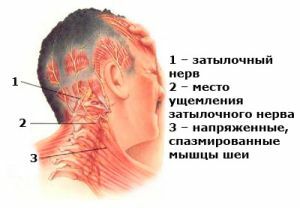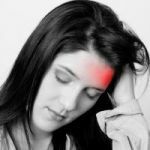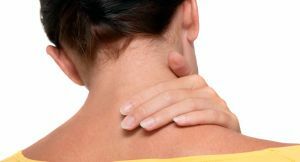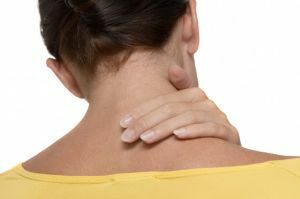 Do you know a headache? Even if you are an absolutely healthy person, you are probably already familiar.
Do you know a headache? Even if you are an absolutely healthy person, you are probably already familiar.
Headache is a companion of very many diseases, or simply a result of experiences, overwork.
One of the factors that provokes headaches is neuralgia of the occipital nerve.
Contents
- Functions of the occipital nerve
- What happens with neuralgia?
- What symptoms
- diseases Diagnostic techniques
- Medical
- Conservative treatments treatment
- Drug treatment
- Surgical treatments
- Home Treatment
- Possible complications
- prevention of neuralgia
functions occipital nerve
begin with where the occipital nerve, and what is itsrole?
The sensory branches of the nerves of the cervical plexus pass through the extremity of the muscle between the breast and collarbone, stretching further under the muscle in the neck region. In the cervical plexus is the occipital nerve( as well as the large ear, transverse, supraclavicular nerves) - behind the second cervical vertebra.
This structure, like many other nerves, provides the connection of tissues and organs to the central nervous system, supplying them with nerve impulses .
What happens with neuralgia?
The main cause of neuralgia of the occipital nerve - is the irritation( squeezing) of nerve root , which is located in the occipital region.
Sensitive fibers in the roots, in the occurrence of structural disorders, give frequent impulses, which are manifested by pain.
Neuralgia can occur without the presence of a provoking element( primary, idiopathic, essential) or as a result of the influence of external factors and concomitant diseases( i.e., secondary, symptomatic neuralgia).
What are the causes of neuralgia of the occipital nerve:
- osteochondrosis of the spine in the cervical region( damage to the nucleus in the vertebra) is the most common cause;
- trauma to the back or neck, because of which the nerve fibers are squeezed;
- hypothermia of the occipital nerve;
- osteoarthritis of the cervical spine;
- overstrain of the neck muscles and shoulder girdle: as a result of a constant sitting position - behind the wheel, in the office, at the computer, at the desk( muscles contract due to spasm, chronic neuralgia develops);
- infections that affect the nervous tissue: encephalitis, meningitis;
- tumors of various origin and location: in the cervical vertebrae or in the brain;
- autoimmune diseases, during which immunity destroys the nerve cells of the body: multiple sclerosis, rheumatoid arthritis, lupus erythematosus;
- gout;
- diabetes;
- inflammatory processes of blood vessels( endaarteritis, for example);
- stress, constant overwork, negative emotional outbursts;
- tuberculosis spondylitis;
- severe form of colds( SARS, sore throat).
Accurately identifying the cause of the disease, you can successfully eliminate it( in most cases) and repair the damaged nerve roots.
What are the symptoms of the disease
Let's just say, you can hardly not notice the appearance of this disease.
Neuralgia of the occipital nerve has the main symptom - this pain .Which one? More details below:
- burning, throbbing pain in the nape;

- often passing into "shooting";
- , many patients report that the condition is very similar to migraine;
- most often the pain is palpable on one side, but sometimes with two;Nasal neck movements can provoke pain;
- sometimes even combing or other touching the scalp provokes pain;
- less often the pain occurs when you lightly touch the skin of the neck;
- bright light causes pain in the eyes and above them;
- sometimes pain occurs when coughing or sneezing;
- sometimes has the feeling that something cuts his head or if it is about to explode;
- can give pulsation in the ear or lower jaw;
- turns and head inclinations increase pain.
As you may have guessed, neuralgia of the occipital nerve is exactly the case when they say "life is pain".
But in addition, the neuralgia of the small occipital nerve has the following symptoms:
- head movements can cause nausea and sometimes vomiting;
- hypersensitivity in the problem area of the neck, increased discomfort during palpation;
- vegetative disorders: sensation of crawling, cold, numbness, red or white skin on the affected area, lacrimation;
- if the disease runs long enough, a site that is provided with a damaged nerve may lose sensitivity.
 Such an unpleasant and difficult to cure cluster headache can be stopped. Read the details in our material.
Such an unpleasant and difficult to cure cluster headache can be stopped. Read the details in our material.
Effective, but very expensive product of Excerdine, analogues of which help not worse, but are much cheaper. Find out specific recommendations for choosing drugs-synonyms.
Diagnostic techniques
Because headaches can have a diverse etiology, you need to describe your feelings to the doctor( orthopedist or neurologist) as accurately as possible.
He must listen very carefully to you, compare the symptoms with your attendant conditions and suspect the presence of neuralgia.
Further is assigned the relevant studies of , which will help confirm / deny the presence of the disease, and most importantly - to correctly identify its cause.
For this, the following diagnostic methods are used:
- computed tomography( using X-rays, the monitor displays a structural image of the spine in the cervical region and layers of tissues in the study area) - it is considered that this is the most successful method for studying this disease;
- MRI( magnetic resonance imaging) - the study of bones and soft tissues in the affected area with the help of electromagnetic waves.
Treatment procedures
 A timely diagnosed disease and the correct identification of its causes will help to successfully get rid of discomfort and possible further structural disturbances.
A timely diagnosed disease and the correct identification of its causes will help to successfully get rid of discomfort and possible further structural disturbances.
If you follow all the recommendations of the doctor, then you will be able to recover.
If the disease is diagnosed at the initial stage, it is possible to avoid invasions and confine oneself to drugs, compresses and massages.
Conservative methods of treatment
Treatment of neuralgia of the occipital nerve conservative methods aimed at removing pain, inflammation and removal of pinching. Do not imply surgical intervention:
- the first rule is the rest and the maximum amount of passive rest;
- therapeutic massage - relieves muscle spasms in the massaged area, improves blood circulation, helps to cope with the pain syndrome;
- heat compresses on the problem area;
- other types of physiotherapy , which warm up the affected tissue( ultrasound, laser therapy).
- LFK ( sets of exercises aimed at removing muscle spasm in the occipital area, strengthening the muscles of the neck and back);
- acupuncture - the effect on the reflex points due to which the metabolism is normalized, the circulation in the treated area is improved, the elimination of pathologies is stimulated;
- manual therapy - the specialist restores the correct position of the joints or mechanically creates optimal conditions for maximum effectiveness of the course of treatment.
Drug treatment
Among the main:
- the use of drugs that have a relaxing effect on the muscles( sirdalud, midokalm);
- anticonvulsants: finlepsin, gabapentin;
- anti-inflammatory steroid drugs that effect blockade of the affected nerve( metipred, hydrocortisone, dextamethasone, kenalog) - administered subcutaneously, to the affected area;
- pain killers;
- sedatives( amitriptyline, duloxetine);
- vitamins of group B.
The described methods can be used both for temporary elimination of symptoms and for full treatment. This will depend on the cause of neuralgia.

In the photo the list of acupuncture points for the treatment of neuralgia of the occipital nerve
It is advisable to approach the problem in a comprehensive manner, to rely on the general symptomatic picture, to take into account the causes of the disease and the accompanying conditions.
If all these methods do not work, how to treat neuralgia of the occipital nerve?
Surgical intervention of will be indicated in case the neuralgia is at a neglected stage or conservative intervention has not yielded visible results.
Surgical treatment methods
The main available operations:
- Microvascular decompression: during the operation, the occipital nerve is eliminated. This method is used if the occipital neuralgia arose as a result of compression, respectively. The surgeon identifies the vessels that squeezed the nerve, performs appropriate corrective manipulations. After that, the sensitivity of the nerve roots decreases, and they come to a normal state. Accordingly, the pain passes.
- Neurostimulation: to the nerves are led by special wiring, which conduct electrical impulses( they block painful impulses).The neurostimulator is implanted under the skin in the neck area. The action of the device can be adjusted by switching the power modes to recreate the most comfortable state. Where previously there was pain, the patient experiences a smoothly spreading pleasant warmth or a slight vibration. The positive side of this technique: the absence of side effects on the body and a minimum of damage to the covers.
After elimination of symptoms for a long time, a spasm in the neck passes, muscles relax - this can remove the "clamp" of the nerve.
If conservative or surgical intervention has not eliminated the problem and pain has persisted, then a thorough, thorough examination is performed. However, this happens rarely enough.
Home Treatment
Exclusively by folk remedies, it is unlikely to cure neuralgia, but home methods can become a very important component of complex therapy - in combination with other therapeutic techniques:
- Herbal bath. Prepare an infusion of thyme, oregano, peppermint( 1 tablespoon of each herb into a glass of boiling water), pass the liquid through the cheesecloth and add it to the bath with hot water. Then lie down in the bathroom for 10 minutes. Perform every day, for a month.
- Compresses. Grind vegetables: potatoes, pickled cucumber, onion. Pour the slurry with diluted wine vinegar, allow the mixture to infuse for several hours( stir occasionally).Compresses are applied to the frontal and occipital zones, in the morning and in the evening. The procedure lasts one hour.
- Ear drops. In the ear, drip a couple drops of raw beet juice. Alternatively, you can wrap the beetroot in gauze and put a swab in your ear( from the side of pain).
- Herbs inside. Fill with 2 tsp. Dried grass lumbago open( do not use fresh, it's poisonous!).Take once a day, 50 milliliters.
Possible complications of
 If the treatment is not timely treated, then serious, irreparable damage to health can be caused.
If the treatment is not timely treated, then serious, irreparable damage to health can be caused.
The state of the occipital nerves will worsen, destructive processes worsen.
Nerve damage can lead to the following serious consequences and problems:
- permanent, drug-dependent headache;
- blindness;
- torticollis( often patients remain disabled until the end of life);
- associated psychiatric disorders caused by persistent pain.
Prevention of neuralgia
Measures aimed at preventing this disease are simple enough. They can be performed by each:
- is a sufficient, balanced amount of physical activity in your daily life;
- beware of injuries to the neck, occiput and back;
- protect your neck from cold;
- if your job implies a sedentary lifestyle, perform regular small workouts;
- provide the body with enough vitamins.
You can not completely protect yourself from the possibility of neuralgia, but try to do everything that depends on you, and the disease will bypass you!
"God takes care of the birch".



